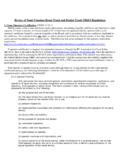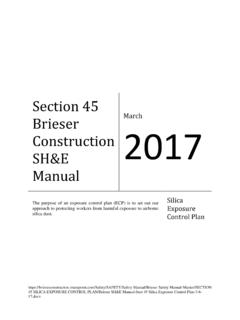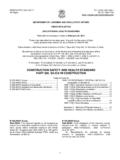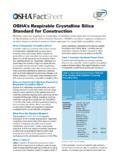Transcription of Respirable Silica Exposure Control Plan (ECP)
1 Respirable Silica Exposure Control plan (ECP) Control methods for cutting, drilling ,grinding, chipping, jackhammering and polishing of stone, concrete and asphault Cutting concrete without proper dust controls can generate high levels of Silica -containing dust. Breathing in this fine dust can cause a serious lung disease called silicosis, which is characterized by scarring and thickening of the lungs, and can ultimately result in death. Health hazards from Silica Exposure Long-term Exposure to airborne crystalline Silica ( , quartz) can cause a disabling, sometimes fatal lung disease called silicosis.
2 When the dust is inhaled deep into the lungs, microscopic particles of Silica can cause scar tissue to form in the lung tissue, which restricts the lungs ability to extract oxygen from the air. This damage is permanent, but symptoms of the disease may not appear for many years. The disease initially causes fatigue and shortness of breath. If Exposure continues, it can lead to chest pain, heart problems (difficulty breathing can strain the heart), and respiratory failure. Purpose and responsibilities We have a duty to protect our workers from Silica Exposure during concrete cutting, grinding and drilling.
3 Studies show that work tasks involving the cutting, grinding, and drilling of concrete generate airborne Silica levels well in excess of safe levels. Effective controls are available to protect workers from harmful Exposure . A combination of Control measures will be required to achieve this objective. We commit to being diligent in our efforts to select the most effective Control technologies available, and to ensure that the best practices, as described in this Exposure Control plan (ECP), are followed at our worksites. The work procedures we establish for cutting, drilling, grinding, chipping or jackhammering of concrete will protect not only our workers but also any other workers on-site who are not involved in these operations.
4 The City of Victoria is responsible for the following: Ensure that the materials, tools, equipment, personal protective equipment and other resources ( training) required to fully implement and maintain this ECP are readily available where and when they are required Ensure that supervisors and workers are educated and trained to an acceptable level of competency in the hazards of Silica Exposure and trained to work safety with Silica Exposure Control plan for Cutting, Grinding and Drilling Concrete Aug 2009, Mar 2010 2 Maintain records of training, fit-test results, crew talks, and inspections (for equipment, PPE, and work methods and practices)
5 Conduct an annual review (or more often if conditions change) of the effectiveness of the ECP. This includes a review of available dust Control technologies to ensure these are selected and used when practical Coordinate the work with the prime contractor and other employers to ensure a safe work environment Supervisors are responsible for the following: Provide adequate instruction to workers on the hazards associated with the cutting, drilling, grinding, chipping or jackhammering of concrete, cutting fibre cement board or cutting, grinding or polishing of stone Select and implement the appropriate Control measures Ensure that workers using respirators have been properly fit-tested and that the results are recorded and maintained Ensure that work is conducted in a manner that ensures the risk to workers and others is minimized and adequately controlled.
6 This includes ensuring that workers use appropriate engineering controls and wear the necessary PPE. Workers are responsible for the following: Use the assigned protective equipment in an effective and safe manner within the scope of their training Follow established work procedures as directed by the supervisor Report any unsafe conditions or acts to the supervisor Report any Exposure incidents or any signs or symptoms of Silica illness Risk identification and assessment Concrete can contain a high percentage of Silica Cutting, drilling, grinding.
7 Chipping or jackhammering without the use of proper dust controls and PPE can expose workers to levels of airborne Respirable crystalline Silica that are above the Exposure limit listed in the Occupational Health and Safety Regulation Work locations where workers or other persons are exposed to the hazards of Silica will be identified with signs, placards, or barrier tape Exposure limits The occupational Exposure limit (OEL) for Respirable crystalline Silica (including quartz) is milligrams per cubic metre (mg/m3). Because crystalline Silica is linked to lung cancer, workplace exposures must be reduced to levels that are As Low As Reasonably Achievable (ALARA) below the OEL.
8 Exposure Control plan for Cutting, Grinding and Drilling Concrete Aug 2009, Mar 2010 3 Silica dust Control The Regulation requires employers to select Silica dust controls based on the following hierarchy: Engineering Administrative controls Personal protective equipment (PPE) Use of respirators as a primary Control is not acceptable when other methods are available and practical Respirators will be used in conjunction with other controls such as wet cutting, grinding, and drilling to reduce worker Exposure to Silica , unless air monitoring information suggests otherwise Wet cutting, grinding, and drilling or the use of local exhaust ventilation (LEV)
9 Are the preferred engineering methods and will be used when practicable Dry cutting, grinding, and drilling will be avoided unless additional respiratory protection and other controls are used Dry cutting or grinding methods might be required for certain applications or work locations. If this is the case, dry work will be isolated from other work areas. Effective LEV will be used in order to Control the dust. A HEPA vacuum will be used for cleanup and decontamination Air discharged from an LEV system will not be re-circulated into the work area Exposure Control plan for Cutting, Grinding and Drilling Concrete Aug 2009, Mar 2010 4 Acceptable Control methods for: cutting concrete The work methods in the following table are acceptable, provided that the respirator selection is adhered to.
10 The following Control options will be used to eliminate or reduce the risk to workers from the hazards of Silica dust Exposure , unless air monitoring information suggests otherwise: Work activity Dust suppression Other Controls Respirator type Cutting or splitting pavers or blocks with a hand powered splitter None Barriers (for example, a tape barrier) to restrict access to the work area N95 single use respirator Small cuts of 2-3 meters using a saw HEPA vacuum extraction or continuous water spray Barriers (for example a tape barrier) to restrict access to the work area Half face respirator with 100 series (N, P or R)








